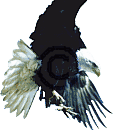


The Bald Eagle is truely an impressive bird, with a wingspan averaging nearly seven feet! The Bald Eagle is identified by it's distinctive white head and tail, and the bright yellow beak. These distinguishing traits, however, do not show up until the bird reaches adulthood, taking three or four years. Juvenile bald eagles have brown heads and tails, and only a yellow tinged beak; and hence, they are easily confused with those of the mature golden eagles. The coloring of juvenile bald eagles looks more mottled and blotchy than the crisp patterns of the golden eagle.
The breeding season of bald eagles varies with latitude. The general tendency is for winter breeding in the South with a progressive shift toward spring breeding in northern locations. In the Southeast, nesting activities generally begin in early September; egg laying begins as early as late October and peaks in late December. The female does most of the nest construction but the male assists. The typical nest is constructed of large sticks with softer materials such as dead weeds, cornstalks, grasses, and sod added as nest lining. Bald eagle nests are very large, sometimes measuring up to 6 feet in width and weighing hundreds of pounds. Many nests are used year after year. Eagles may lay from one to three eggs, but the usual clutch size is two eggs. A second clutch may be laid if the first is lost. Incubation lasts 34 to 38 days. The young fledge 9 to 14 weeks after hatching but parental care may continue for another 4 to 6 weeks. Bald eagles reach sexual maturity at 4 to 6 years of age. Life span is not known, but it is potentially long since eagles have been known to live for 50 years in captivity.
There are certain general elements which seem to be consistent among nest site selection. These include (1) the proximity of water (usually within one-half mile) and a clear flight path to a close point on the water; (2) the largest living tree in a span; and, (3) an open view of the surrounding area. The proximity of good perching trees may also be a factor in site selection. An otherwise suitable site may not be used if there is excessive human activity in the area. Bald eagle wintering areas possess many of the same characteristics as nest sites. The birds, however, are not as closely limited to shores at this time, with both adults and immatures gathering food where it is most easily available. Roost sites are an important component of wintering areas. Eagles may roost singly or in groups exceeding one hundred birds.

